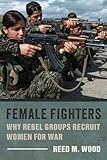Female Fighters : Why Rebel Groups Recruit Women for War / Reed M. Wood.
Material type: TextPublisher: New York, NY : Columbia University Press, [2019]Copyright date: ©2019Description: 1 online resource : 25 figuresContent type:
TextPublisher: New York, NY : Columbia University Press, [2019]Copyright date: ©2019Description: 1 online resource : 25 figuresContent type: - 9780231192989
- 9780231550093
- 355.2/3082 23
- U21.75 .W67 2019
- online - DeGruyter
- Issued also in print.
| Item type | Current library | Call number | URL | Status | Notes | Barcode | |
|---|---|---|---|---|---|---|---|
 eBook
eBook
|
Biblioteca "Angelicum" Pont. Univ. S.Tommaso d'Aquino Nuvola online | online - DeGruyter (Browse shelf(Opens below)) | Online access | Not for loan (Accesso limitato) | Accesso per gli utenti autorizzati / Access for authorized users | (dgr)9780231550093 |
Frontmatter -- Contents -- Figures and Tables -- Acknowledgments -- Abbreviations -- Introduction -- 1. Why Rebels Mobilize Women for War -- 2. The Strategic Implications of Female Fighters -- 3. Female Combatants in Three Civil Wars -- 4. Empirical Evaluation of Female Combatant Prevalence -- 5. Empirical Evaluation of the Effects of Female Combatants -- Conclusion: Understanding Women's Participation in Armed Resistance -- Appendix A: Version History -- Appendix B: Examples of Coding Narratives from WARD -- Appendix C: Survey Wording and Instrument -- Notes -- References -- Index
restricted access online access with authorization star
http://purl.org/coar/access_right/c_16ec
The presence of women combatants on the battlefield-especially in large numbers-strikes many observers as a notable departure from the historical norm. Yet women have played a significant active role in many contemporary armed rebellions. Over recent decades, numerous resistance movements in many regions of the globe have deployed thousands of female fighters in combat.In Female Fighters, Reed M. Wood explains why some rebel groups deploy women in combat while others exclude women from their ranks, and the strategic implication of this decision. Examining a vast original dataset on female fighters in over 250 rebel organizations, Wood argues rebel groups can gain considerable strategic advantages by including women fighters. Drawing on women increases the pool of available recruits and helps ameliorate resource constraints. Furthermore, the visible presence of female fighters often becomes an important propaganda tool for domestic and international audiences. Images of women combatants help raise a group's visibility, boost local recruitment, and aid the group's efforts to solicit support from transnational actors and diaspora communities. However, Wood finds that, regardless of the wartime resource challenges they face, religious fundamentalist rebels consistently resist utilizing female fighters. A rich, data-driven study, Female Fighters presents a systematic, comprehensive analysis of the impact women's participation has on organized political violence in the modern era.
Issued also in print.
Mode of access: Internet via World Wide Web.
In English.
Description based on online resource; title from PDF title page (publisher's Web site, viewed 02. Mrz 2022)


